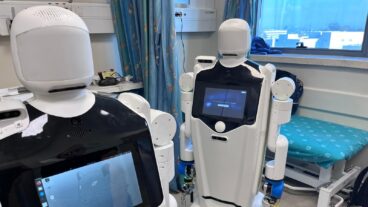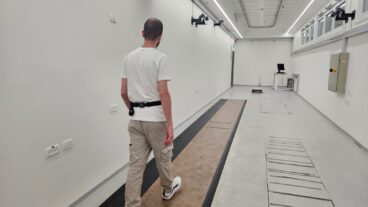The SmartAssist line’s first product, SpineAssist, is designed for delicate spinal procedures that require a high level of accuracy and experience.
Ori Hadomi, CEO of Mazor Surgical Instruments, likes to think of the company’s emerging product line, SmartAssist, as a kind of taxi cab for complex surgical procedures. All the surgeon has to do is tell the driver, or in this case the software, where he wants to go and the miniature robotic system will take him there on the shortest possible route, directing him to the precise spot where surgery should take place.
The platform, which took the Caesaria start-up just two years to develop, incorporates patent pending software, and a guidance device based on miniature robotic technology. It can be used in a whole range of procedures from orthopaedics, to neurosurgery, knee replacement and trauma, but the company’s first product, SpineAssist, is designed for delicate spinal procedures that require a high level of accuracy and experience.
The first application of SpineAssist is for pedicle screw insertion in spinal fusion procedures. In this operation, surgeons must insert screws, which are about four to five millimeters wide, into a space on the vertebrae that is about 6-7mm wide. That leaves 1mm on each side. If you miss the exact spot you can cause paralysis in the patient.
SpineAssist displays the vertebras through 2D and 3D visualizations of CT images. Using this information, the surgeon chooses the appropriate available implant and positions it at the right location on the CT image. This can be carried out on any laptop or PC, allowing pre-operative planning to be done off-site at the surgeon?s convenience.
Once this is completed a disposable plastic clamp is clamped onto a vertebra and the surgical guidance device, which is 2.5 inches in size and weighs just 250 grammes, is then fixed to it. Using the information from the CT image, the device automatically guides the surgeon to the exact location where drilling should take place.
An external bridge can be attached to the clamp enabling the device to find the precise location on all the vertebras, without having to move the clamp. This ensures that the spine surgery goes ahead with minimal invasiveness.
The beauty of the SpineAssist device, according to Hadomi, is its simplicity, reliability, and ease of use. “You don’t need significant training or calibration to use this system,” he explains. “The SpineAssist synchronizes with the surgeon?s own skills and is expected to significantly improve success rates.”
In addition, the device is not affected by environmental interference, such as temperature, noise, or humidity. The tiny size of the device also adds to its appeal, says Hadomi, since it does not block the surgeon?s vision or movement.
“It is the first robotic system that is small enough and light enough to be attached to live tissue,” says Hadomi.
In the future, Hadomi hopes that SpineAssist will also be used in other complex spine procedures including minimally invasive tumor extractions, biopsy, and artificial disc placement. This is a huge potential market. According to Hadomi some 600,000 spinal procedures take place every year in the US alone. He predicts that from this product alone, the company could make up to $60m.
The company is also now developing a number of other applications including KneeAssist, which will help surgeons involved in knee replacement procedures, and NailAssist, which will provide exact positioning for drilling pilot holes and placing distal screws in the body.
SpineAssist is now in the late stages of development and in September the company will begin clinical trials on 30-40 patients. The trials are to be conducted in a number of Israeli hospitals. Some of the operations will be carried out by five surgeons from three leading medical centers in the US, who are expected to fly out in November or December this year.
“This will save us time and money, and at the same time provide us with great exposure,” admits Hadomi enthusiastically. “We will learn some valuable lessons by having surgeons of this caliber using our equipment.”
If the trials are a success, Mazor plans to apply for FDA approval by the end of this year. CE approval, enabling the company to sell to Europe, is expected in the second quarter of next year. The company plans to target the US and European markets at the same time, and will look for distributors, or a large partner in the same sector, to push the product.
Mazor’s platform was originally developed at the Technion Institute by Prof. Moshe Shoham, head of the Robotics Lab at the Technion’s Faculty of Mechanical Engineering, and the director of the Robotics Lab at Columbia University. Early in 2001, Sheram joined forces with Eli Zahavi, the former director of engineering at Elscint, and together they founded Mazor. Initially the company was established in the Technion incubator in Haifa, but soon attracted seed investment of $900,000. In June it held a first round of financing, and raised $8.5m. from venture capital firm, Shalom Equity Fund, Johnson & Johnson D.C., Proseed Venture Capital Fund, DOR Ventures, and Alice Ventures.
Hadomi, who joined Mazor in January this year from DenX, a specialist in image-guided dental surgery, said he was pleased with the results of the round and expected to be able to meet most of the company’s milestones with this amount.
“We could have raised more, but it was the company’s decision to hold the round at this stage, and to raise more in the future if all goes well,” he says. Initially the company planned to raise just $7m., but investor interest was so great that the company boosted it to $8.5m.
The company plans to use this money to increase marketing, open new international offices, and continue R&D. Currently the company employs 13 people, and while Hadomi says he plans to bring on more staff, he also aims to keep the company small.
Though it should be borne in mind that many products fail when they get to the trial stage, Hadomi remains optimistic that Mazor will be a success. He also anticipates great demand for the product. Focus groups held in the US and Canada showed that people liked the product. “There’s nothing like this on the market today,” says Hadomi. “It’s a real revolution.”
As a result, Hadomi admits that competition does not worry him. “The other players in the image guided surgery market accept us as real competition, but I’m not sure that they can compete with us. We have a big advantage because we provide the market for the first time with a simple, reliable and precise system that can be operated with no assistance, and without too many technicians and maintenance,” he says.
In addition, Mazor’s system is likely to be cheaper than existing systems, says Hadomi. SpineAssist, for example, will cost about $100,000 for the equipment, and a further $90 or so per patient for the disposable clamp. Traditional systems start at $300,000.
“I’m very pleased with the approach this company has taken,” admits Hadomi. “The company has done an extremely good job with very limited resources and a short time.”
He attributes this to the experience of the team. “We have an experienced team, all in senior positions in the medical devices community. This makes all the difference.”
(See Exclusive video report on Mazor from IsraelHighTech.TV).













